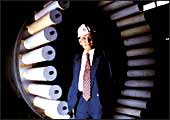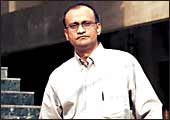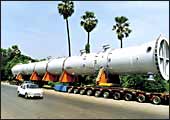 |
 |
| L&T's Naik: His formula for success
is to reinvent constantly |
IVRCL's Reddy: His goals
are clear: become
another L&T |
India's first
prime minister Jawaharlal Nehru had called dams, factories and
infrastructure the temples of modern India. Construction and infrastructure
development companies can be forgiven for thinking that they are
all dedicated to Mammon. That's because the boom in the country's
construction sector is translating into larger toplines and fatter
bottom lines for almost every company operating in it.
Larsen & Toubro, the largest company
in this space, is aiming high. The goal: become an Indian E&C
(engineering and construction) multinational by 2010. And it is
doing so by constantly reinventing itself. "What is core
today will become non-core tomorrow," says A.M. Naik, CMD,
L&T, adding that reviewing its portfolio is an ongoing process
at the company "as you need to get out of businesses during
good times-before they become obsolete". L&T has about
60-odd businesses under its umbrella. Naik's take: any business
smaller than Rs 500 crore that does not contribute significantly
to the profitability of the company is a prime candidate for sell-off.
| Five Things Going For The Sector |
| BEDROCK OF THE ECONOMY:
Infrastructure is seen as the key enabler of rapid
economic growth. Hence, the government is expected to keep
pouring investments into the sector.
NEW GROWTH AREAS: Economic
development is throwing up new opportunities in this sector-airports,
oil and gas pipelines, ports and power plants, to name just
a few.
FULL ORDER BOOKS: Increased
capex by the Centre, states and by private companies have
resulted in bulging order books for most players in this
sector.
HIGH GDP GROWTH RATE: The
economy is expected to canter along at 6 per cent-plus for
the next few years. As companies expand capacities to tap
this opportunity, E&C firms will gain.
RISING KNOWLEDGE GRAPH: Indian
firms are scaling up their knowledge. Result: they are winning
contracts that used to go to foreign players and also winning
overseas contracts.
|
He's confident that sales for the current
year will grow 12-15 per cent from Rs 13,418.38 crore and that
the company's order book position will swell over 50 per cent
to more than Rs 20,000 crore. Providing ballast to these figures
are the government's ambitious highway, electrification and irrigation
programmes. "Next year looks good for L&T. We have a
strong order book; this will improve our profitability,"
says Naik, adding that he expects the company to close 2006-07
with sales of Rs 19,000 crore and net margins of 5-6 per cent.
"This is among the best in the world and in line with those
recorded by global competitors like Tecni and KBR Brown,"
he informs. Expectedly, the E&C division is the crown jewel
within the L&T empire: it contributed Rs 11,400 crore, or
85 per cent, to its topline and Rs 1,100 crore, or 65 per cent,
to operating profits in 2004-05. An interesting sidelight: L&T's
E&C division is four-and-a-half times the size of the second
largest Indian construction conglomerate, Jaiprakash Associates,
which reported revenues of Rs 2,700 crore last year. Says Satyam
Agarwal, Research Analyst, Motilal Oswal: "Given its improving
export margins and bulging order book, we expect the company's
operating margin to improve to 8.5-9 per cent in the next one
year."
Down south, IVRCL, the teenager on the block,
is similarly bullish about its future. "Our target is 3,000
x 4 by 2008," says E. Sudhir Reddy, Vice Chairman and MD
of the 18-year-old company. What he means is that IVRCL has set
itself a target of achieving a turnover (Rs 1,057 crore in 2004-05),
asset base (Rs 1,600 crore at present) and market capitalisation
(Rs 1,479 crore on November 9) of Rs 3,000 crore each, and a manpower
strength (2,100 now) of 3,000 by that date. "There are enough
opportunities in the infrastructure sector," he says, "and
at least 20 players can hope to become like L&T over the next
5-10 years." Needless to add, he's targeting a slot for IVRCL
in this exalted list.
| Five Things That Could Go Wrong |
| GOVERNMENT POLICY: Infrastructure
activity is driven mainly by the political leadership. Any
political change at the Centre can stall the current boom
in the sector.
RISING HR COSTS: Greater demand
for manpower as a result of robust growth in the industry
will result in wage inflation, putting pressure on margins.
CAPITAL COSTS: Could go up
if the interest rates rise. Secondly, companies increasingly
trade in derivatives to hedge foreign exchange risks. This
can be very risky for individual firms.
FOREIGN COMPETITION: Rising
competition from foreign companies will squeeze margins.
With import duties cut to zero levels, Indian companies
start with a 7 per cent handicap.
TALENT CRUNCH: Young engineers
and professionals prefer IT, consultancy and FMCG companies
because of higher pay and the glamour quotient. This may
affect the sector in future.
|
Like most other players in this sector-and,
indeed, like L&T, despite its protestations to the contrary-IVRCL
is looking to upgrade its skills by tying up with global giants
(see Hegemon or Benefactor?). And although it is executing projects
in a wide variety of sectors-roads, rural development, nuclear
plants, etc.-it sees itself mainly as a niche player with a focus
on the water sector, which accounts for 58 per cent of its total
orders in hand of Rs 4,500 crore. Besides, it is implementing
another Rs 1,600-crore worth of build, own, transfer (BOT) projects.
Such healthy order books-and this phenomenon
prevails across the industry-will reduce competitive intensity
in the sector and boost the margins of bigger players like L&T
and IVRCL. Why? Most players are more focussed on executing orders
rather than winning new ones, says a BRICS Securities report.
And L&T, in particular, is passing up contracts which will
not give it the desired margins.
In order to maintain its lead over the competition,
L&T has broadened its construction portfolio to encompass
a whole range of construction activities, from road projects to
high-end power, oil and gas projects. This diversification has
given it the size and scale required to capitalise on the opportunities
thrown open by the government's Rs 1 lakh-crore infrastructure
development programme (as of March 2005; analysts estimate that
the figure could increase to over Rs 2 lakh crore by 2010). L&T
is also exploring opportunities in the construction and development
of ports and airports and is also likely to enter the ship-building
business soon.
Another factor helping L&T is the increase
in the average order size from Rs 300-400 crore a few years ago
to Rs 800-1,000 crore now. Since customers typically prefer to
place their orders with big players, the E&C division of L&T
is ideally poised to leverage its size and track record of successful
project implementation to win a significant chunk of orders flowing
from fresh investments in infrastructure. "L&T is definitely
much more competitive than its smaller rivals, especially when
it comes to huge, complex projects which call for skills across
a spectrum of sectors," says a Mumbai-based consultant.
| Hegemon Or Benefactor? |
 |
| Smooth ride: A highway project
executed by IVRCL |
The infrastructure and construction
space in India is moving up the value chain. As projects become
more complex, high technology processes play an increasingly
important role in their execution. Not surprisingly, Indian
companies are sourcing technology either by forming joint
ventures (JVs) with foreign companies or by taking over Indian
companies that have it.
Larsen & Toubro, India's numero uno infrastructure
development company has a slew of joint ventures and associates-last
year, its JVs reported a combined turnover of Rs 1,600 crore-but,
surprisingly, it is wary of tying up with foreign partners.
Says A.M. Naik, CMD, L&T: "I am dead against JVs
in my core business. I don't want foreign partners. JVs
survive only if technology transfers are a part of the agreement.
Unless the Indian partner absorbs new technologies, you
can be rest assured that the foreign company will soon issue
it marching orders."
L&T can afford that attitude, but JVs still add value
to smaller companies like IVRCL. "A JV can make a difference
if it brings complementary strengths together. An international
partner can also bring international exposure at an early
stage. However, the partner should be part of the project
and not just a balance sheet lender," says E. Sudhir
Reddy, Vice Chairman and MD, IVRCL Infrastructure Projects
Limited. The company's tie-up with Befesa of Spain in the
niche water space helped it win a Rs 500-crore desalination
project from the Chennai Metro Water Supply & Sewerage
Board. The design, build, own, operate and transfer (DBOOT)
project is the first such project in India. "We hope
to learn from them how a large full-fledged desalination
plant can be built at low cost and still be technologically
advanced and also learn how to operate and maintain this
plant," says Reddy.
Following this JV, Reddy says, he is now considering tying
up with GE Water and Pall Filtration, both of the US, for
future projects. Incidentally, IVRCL acquired Hindustan
Dorr-Oliver from the Dubai-based Jumbo Group in September
2005 to leverage its design, technical and manufacturing
knowhow, especially in the water space and move up the knowledge
chain. Says Reddy, "Hindustan Dorr-Oliver adds strength
to our core areas of water and sewerage management and brings
new products and services to IVRCL's portfolio."
That JVs add value to Indian companies is undeniable.
Despite its reservations, L&T has seven of them in sectors
ranging from injection-moulding machines (L&T-Demag
Plastic Machinery), dredging (L&T Dredging International),
hydraulic excavators (L&T-Komatsu), industrial valves
and safety systems (Audco), earth-moving and construction
equipment (L&T Case Equipment Private Limited), paper
industry solutions (Voith Paper Technology) and welding
and repair solutions (EWA Alloys Limited.)
|
Currently, L&T is working on 15 major
projects, and several smaller ones, including five overseas ones.
It has also recently won orders worth Rs 3,050 crore. These include
a Rs 1,000-crore order from Tata Steel to expand its blast furnace
capacity, another one from Hyderabad Airport (Rs 500 crore), a
residential complex in the UAE (Rs 340 crore) and the Muscat Water
Supply & Pipeline Project in Oman (Rs 200 crore).
 |
| Going places: An absorber made by L&T
for Kellog Woodside Energy |
The L&T management is also trying to create
further value for its shareholders by rejigging its portfolio
and by setting up holding companies for some of its businesses.
For example, it has set up L&T Infrastructure Development
Projects Ltd as a holding company for its investments in the infrastructure
sector and L&T Power Investments Ltd for its power sector
foray. It is also considering another holding company for its
property development business. The intention is very clear: have
focussed, integrated businesses, which can unlock shareholder
value under one roof. "This structure will allow L&T
to mobilise funds through its subsidiaries without any effect
on its own cash flows," says Agarwal of Motilal Oswal Securities.
In line with its goal of becoming a multinational
E&C company and also to hedge the risk of operating in a single
country, L&T is expanding into new geographies as well. The
goal: have a footprint spanning 14 countries by 2010. The geography:
West Asia, China and Africa. In fact, it will inaugurate a switchgear
manufacturing unit in China in January 2006. The Electricals &
Electronics (E&E) division of L&T, of which the switchgear
unit is a part, contributes only around 9 per cent of total revenues
(2004-05), but it is growing at a fast clip. "Our international
operations are expected to contribute 25 per cent of total revenues
by 2010 (current level: 17 per cent)," says Naik. By then,
L&T hopes to achieve a topline of over Rs 25,000 crore. But
there are fears that L&T's focus on the international market
may leave it open to damage and other claims in case of time overruns
or any other failure.
| FAQs |
| Are the companies in a sector where India
has a long-term competitive advantage?
Yes, it is a growth sector in India. There is serious
government backing, both at the central and state levels.
Do the companies have what it takes to succeed in the
long term?
L&T is the undisputed market leader and IVRCL a serious
niche player in the water segment of the infrastructure
development sector. Both are expected to survive and thrive
in the medium- to long-term.
Should you invest in the companies (sector)?
By all means. L&T is considered a surrogate for the
sector and looks set to maintain its record. IVRCL also
looks a good long-term bet. The sectoral outlook looks bullish
and good companies within it will continue to make money.
|
Also, managing input costs is always a tough
ask, especially in an industry where project lifespans extend
to several years. Both L&T and IVRCL try and cover this risk
by focussing only on large projects at the top end of the market
where technology becomes a barrier for small operators, thus,
protecting themselves against undercutting by price warriors.
L&T goes a step further and insists on an escalation clause
linked to the cost of raw materials. Alternatively, it insists
that its customer supply it with inputs which are susceptible
to price fluctuations. "We cannot afford to let our margins
slip. Therefore, 80-90 per cent of our project contracts have
price escalation clauses," says Naik. There are, however,
concerns that if there are significant cost escalations in L&T's
fixed price contracts, they could eat into the company's overall
margins and put pressure on its profitability. IVRCL also follows
a similar strategy. "Most of our contracts have escalation
clauses. That apart, we protect our margins by focussing on efficient
implementation of projects and by spreading our risks across a
larger number of them. Besides, like many other players in this
sector, we are taking the JV route to hedge our risks," says
Reddy.
"Given L&T's size and order book
position, there is no cause for concern in the near- to medium-term,"
says Gurunath Mudlapur, MD, Atherstone Institute of Research.
But he wonders if L&T can maintain its lead in the long term.
"Competitors are growing at a faster pace and can, in the
long term, eat into L&T's market share." In fy2004-05,
L&T had the lowest current orders backlog to net sales ratio
among its peers like HCC, Gammon and IVRCL. This, he says, implies
that its competitors are bagging a larger share of new orders
than L&T. IVRCL, on the other hand, has nothing to worry on
this count: Its order book can sustain its current sales level
for almost six years.
For now, both companies are viewing the future
with confidence. "We are looking to build up our manpower
and knowledge levels and increase our focus on the water sector,"
says Reddy. His in-house design team has already grown more than
three-fold from 45 to 145 since August following the takeover
of Hindustan Dorr-Oliver. Reddy wants to ramp this up to 250 by
2008, by which time, he hopes, his 3,000 x 4 initiative will have
reached its target. And Naik is confident that by then, L&T
will have spread its wings further and be closer to its goal of
becoming the first Indian MNC in the E&C sector.
|







